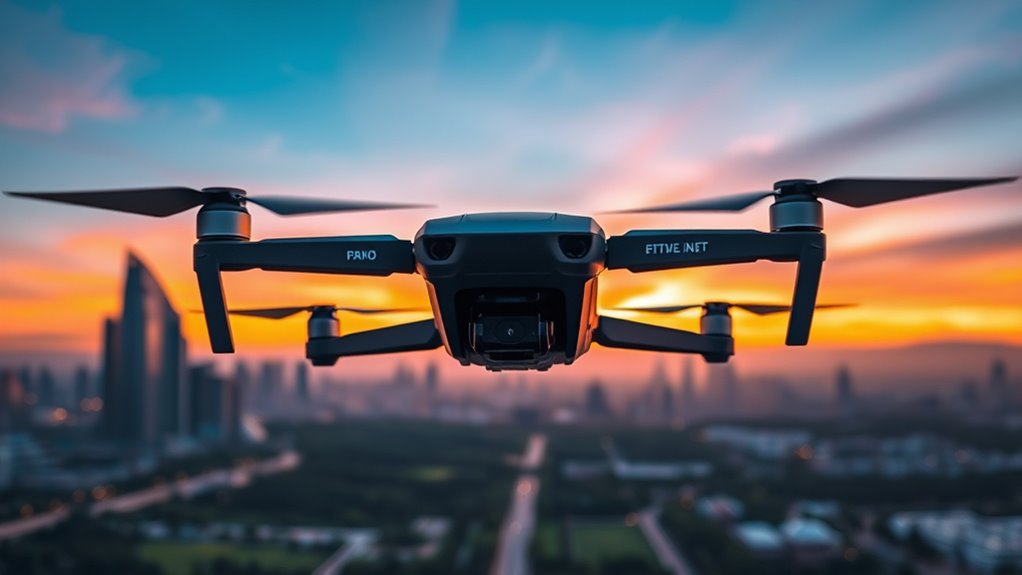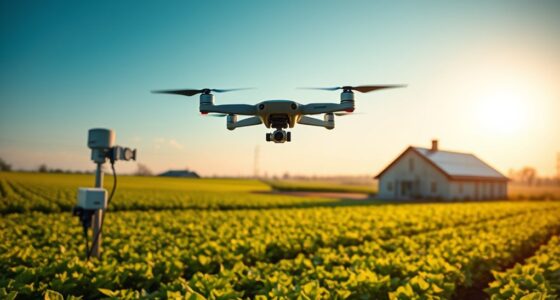AI is transforming drone development by enabling fully autonomous flights with advanced sensor integration, real-time data processing, and adaptive decision-making. You’ll find things like high-resolution cameras, LiDAR sensors, and machine learning algorithms helping drones navigate complex environments safely. These systems analyze surroundings instantly, avoid obstacles, and make smart choices on the fly. If you want to see how these technologies work together, continue exploring, and you’ll uncover even more about the future of drone innovation.
Key Takeaways
- AI enables real-time sensor data processing for obstacle avoidance and environment mapping.
- Machine learning algorithms improve drone adaptability through continuous data-driven updates.
- Sensor fusion combines visual, LiDAR, and other data for comprehensive environmental awareness.
- Path planning algorithms analyze sensor inputs to optimize flight routes and ensure safety.
- Edge computing facilitates instant decision-making and autonomous responses in dynamic settings.

Have you ever wondered how drones can navigate complex environments without human help? The secret lies in the principles of AI-powered systems that drive their autonomy. AI enhances a drone’s ability to perform intricate tasks efficiently, making it possible for them to operate independently in unpredictable settings. Central to this capability is computer vision, where high-resolution cameras and LiDAR sensors capture detailed visual data. This data is processed in real-time, allowing drones to interpret their surroundings instantly and accurately. This process is supported by advanced sensor fusion techniques that combine data from multiple sources to improve environmental perception. When you see a drone avoiding obstacles or scanning an area, it’s AI working behind the scenes, analyzing visual input and making split-second decisions. Additionally, data security measures are crucial to protect sensitive information gathered during drone operations from potential breaches. Machine learning plays a crucial role in this process. Algorithms are trained on extensive datasets, enabling drones to adapt to new situations. As they gather more data, they improve their decision-making skills, becoming more reliable over time. Path planning is another essential aspect—AI continuously analyzes sensor data to chart efficient flight paths while avoiding obstacles. This real-time analysis ensures that the drone can navigate complex terrains smoothly, whether it’s flying through a forest, inspecting infrastructure, or monitoring a large agricultural field. When unexpected events happen, AI-driven drones process sensor inputs to respond immediately, often without human intervention, maintaining safety and operational continuity. Additionally, environmental awareness is crucial for ensuring the drone’s safety and effectiveness in diverse conditions. Enhanced algorithms enable drones to perceive their environment better, making quick, accurate decisions. Sensor fusion combines data from multiple sources—cameras, LiDAR, ultrasonic sensors—creating a comprehensive picture of the surroundings. Predictive systems take this a step further by forecasting potential obstacles or hazards, allowing the drone to adjust its course proactively. Neural networks specialize in object detection and autonomous navigation, teaching the drone to recognize and react to various objects in its environment. Moreover, adaptive learning allows drones to refine their responses based on new data, increasing their autonomy and reliability over time. Edge computing ensures all this data processing happens locally, in real-time, without delays, which is crucial for quick decision-making. Additionally, understanding the importance of personal finance management can help drone companies plan their investments strategically to support ongoing AI development.
Frequently Asked Questions
How Does AI Improve Drone Navigation in Complex Environments?
AI improves drone navigation in complex environments by processing sensor data in real-time, allowing you to make quick adjustments. It uses machine learning to recognize objects, avoid obstacles, and plan best routes. With computer vision and LiDAR, you gain detailed environmental insights. AI’s decision-making adapts to new situations and unpredictable changes, enabling your drone to navigate safely, efficiently, and autonomously even in challenging, dynamic settings.
What Are the Main Ethical Concerns Related to Autonomous Drones?
You might think autonomous drones are all about convenience, but their main ethical concerns reveal a different story. They invade privacy with persistent surveillance, capturing private moments without consent. Life-and-death decisions made by AI raise moral questions, especially without human oversight. Accountability becomes murky when systems malfunction. So, while they promise progress, these drones challenge your civil liberties, ethics, and the very definition of responsible technology use.
How Is Ai-Powered Drone Data Secured Against Cyber Threats?
You secure drone data by implementing encrypted communication protocols to prevent unauthorized access. You use role-based access controls to restrict data to authorized personnel and embed systems within existing cybersecurity frameworks. Additionally, you deploy AI algorithms for real-time threat detection, enabling drones to reconfigure routes or respond automatically to cyber threats. Regular security audits and AI-driven simulations help identify vulnerabilities, ensuring your drone data remains protected against cyber attacks.
What Are the Challenges in Real-Time AI Processing for Drones?
They say, “Time waits for no one,” and in drone AI processing, every second counts. You face challenges like limited onboard computational power, which makes real-time data analysis tough. High data volumes strain bandwidth, causing delays. Developing efficient algorithms that balance speed and accuracy is crucial. You also need to minimize latency and manage energy use, ensuring the drone acts swiftly without sacrificing performance or endurance.
How Do Regulatory Policies Impact AI Development in Autonomous Drones?
Regulatory policies considerably impact AI development in autonomous drones. You face strict guidelines like FAA Part 107, which can slow innovation by imposing certification and operational limits. State and international rules add complexity, requiring you to adapt your AI systems accordingly. While regulations aim to ensure safety, they often challenge rapid AI advancement, pushing you to find a balance between compliance and pushing technological boundaries for safer, more capable autonomous drone systems.
Conclusion
As you harness AI to develop autonomous drones, remember they’re more than machines—they’re the wings of tomorrow’s world. Like a compass guiding explorers through uncharted skies, AI steers these drones with precision and purpose. Embrace this innovation, for it symbolizes hope, progress, and the endless horizon of possibility. With each line of code, you’re planting seeds that will help us soar higher and reach further than ever before.











